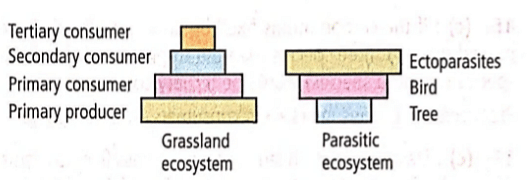Pyramid of numbers is
- always upright
- always inverted
- either upright or inverted
- neither upright nor inverted
The Correct Option is C
Solution and Explanation

Top Questions on Ecological Succession
- Arrange the following ecological succession in the lithosphere (rocks) from initial to final succession stages
(A) Moss stage
(B) Foliose-lichens stage
(C) Herbaceous stage
(D) Crustose-lichens stage
(E) Shrub stage
Choose the correct answer from the options given below:- CUET (UG) - 2025
- Environmental Science
- Ecological Succession
- The species that invades a bare area is referred to as \(\underline{\hspace{2cm}}\).
- CUET (UG) - 2025
- Environmental Science
- Ecological Succession
- Which of the following is a pioneer species in the primary succession of a bare rock?
- MHT CET - 2025
- Biology
- Ecological Succession
- Which one of the following statements is wrong regarding ecological pyramids?
- CUET (UG) - 2024
- Biology
- Ecological Succession
- Which are the pioneer species in aquatic habitats?
- MHT CET - 2024
- Biology
- Ecological Succession
Concepts Used:
Ecological Succession
Ecological succession is the steady and moderate change in a species of a given area with respect to the changing environment. Our nature consists of both biotic and abiotic factors. When these biotic and abiotic factors interact with each other to develop natural communities they give rise to such successions.
Ecological Succession:
When land is left on its own for years, it starts being occupied by microorganisms followed by wild shrubs and other large plants, which gives rise to a new ecosystem. The series of stages is quite predictable and inescapable. In order to understand the primary and secondary succession, we need to be very much clear about what ecological succession is as they are its types. This succession mainly focuses to bring about equilibrium in the ecosystem. When the target is achieved, it is called a climax community.
The number of species to survive is then decided based on achieving the equilibrium. In a community, these changes happen in a sequence, and such a community is known as a seral community which further is an intermediate stage of ecological succession advancing towards the climax community. All the succession begins with an instigating species. The instigate species or the first species build an initial biological community that is simpler in form. The initiation of this ecological succession separates it into the following three types –
- Primary succession
- Secondary succession
- Cyclic Succession